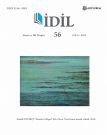HATIRA AHMEDLİ CAFER’İN SOLO OBUA İÇİN “MONOLOG II” ADLI ESERİNİN FORM ANALİZİ
ANALYSIS FORM OF HATIRA AHMEDLI CAFER’S PIECE NAMED “MONOLOG II” FOR OBOE SOLO
Author(s): Selçuk AkyolSubject(s): Music, Present Times (2010 - today), Sociology of Art
Published by: Sanat ve Dil Araştırmaları Enstitüsü
Keywords: Oboe; monologue; form; analyse; şüşter; solo; multiphonics; Glissando;
Summary/Abstract: Hatıra Ahmedli Cafer composed the piece named Monologue II for solo oboe between 2018-2019. Her earlier work, Monologue I, was composed for solo flute. The monologue in musical works emerges as a genre in which the composer reflects his/her ideas, conflicts and inner speeches in his/her inner world. Although it is written in a simple three-part form, it contains a deep philosophy; composer’s inner speeches and conflicts of her ideas. The composer, in her work “Monologue II”, used the “Şüşter Maqam” consisting of two tetrachords with “semiton-wholeton-semiton” intervals combined with augmented second. “Şüşter” is a Azerbaijani Maqam and generally used to describe the suffering of man in musical works. In this work, the composer gave place to multiphonics which is an extended playing technique. Multiphonics is a general name given to two or more sound production technique at the same time from a monologue instrument that can produce a single sound. In addition, a quarter ton glissandi also appear in the work. In order to be able to play the quarter tone glissandi, it would be more appropriate to apply the key glissando technique. In this research, the form and maqam serials will be analyzed and the piece will be examined in terms of performance techniques.
Journal: İdil Sanat ve Dil Dergisi
- Issue Year: 8/2019
- Issue No: 56
- Page Range: 455-462
- Page Count: 8
- Language: Turkish

